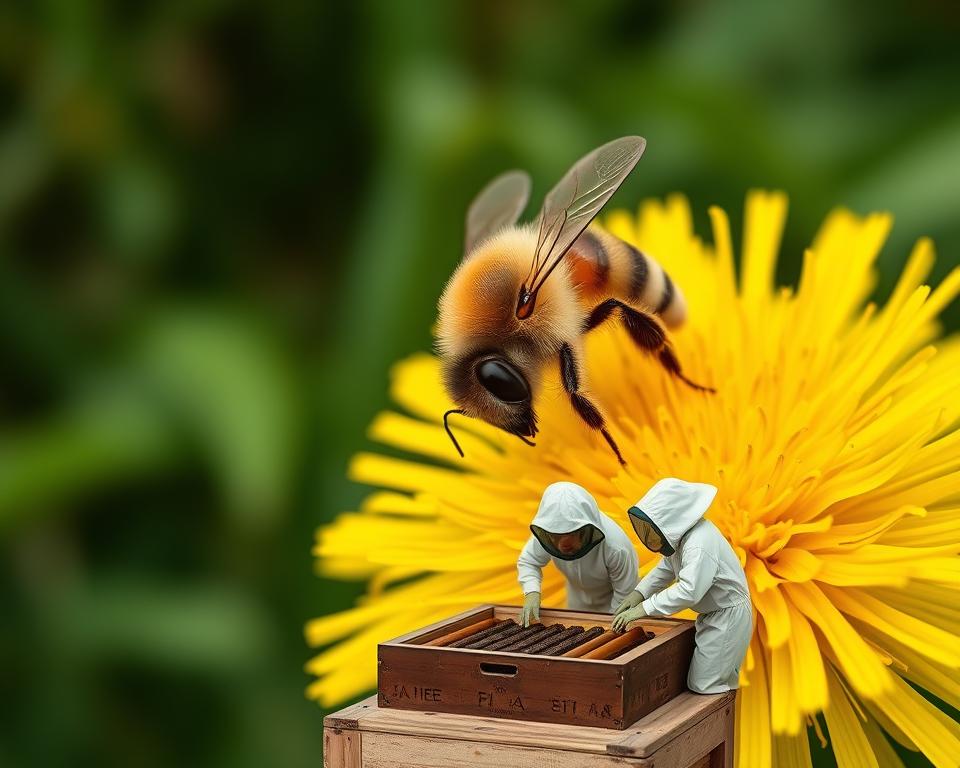One-third of the food we eat depends on honey bee pollination. But, honey bees face many threats, including pesticide use. This can harm their populations greatly.
If you’re into agriculture, knowing about pesticide risks is key. It’s important to protect these vital pollinators. By using effective pollinator protection strategies, we can lessen pesticide harm. This helps keep honey bee colonies healthy and productive.
Key Takeaways
- Apply pesticides in the evening to reduce honey bee mortality.
- Choose formulations that dry quickly and do not leave powdery residues.
- Use less toxic, rapidly degradable pesticides to minimize pesticide exposure.
- Establish apiaries at least 4 miles from crops being treated with toxic materials.
- Feed sugar syrup, pollen, and water to support honey bee health.
Understanding the Importance of Honey Bees
Honey bees are vital for our ecosystem’s health. They play a key role in keeping our environment balanced. Their importance cannot be overstated.
Honey bees are essential for pollinating plants. Without them, many plants would struggle to reproduce. This would harm the health of our ecosystems. The role of honey bees in biodiversity is vital, as they pollinate many crops and wildflowers.
The Role of Honey Bees in Biodiversity
Honey bees pollinate countless plant species. This is key for our food supply. In the United States, they pollinate over 90 commercial crops, like almonds and apples.
Economic Value of Honey Bees
Honey bees add over $15 billion to U.S. agriculture each year. Their pollination services are vital for plant diversity. Bee-friendly farming practices help keep honey bee populations healthy, benefiting farmers.
Threats to Honey Bee Populations
Honey bees face threats like pesticides, habitat loss, and climate change. Honey bee conservation efforts aim to combat these issues. They focus on reducing pesticide use and creating bee-friendly habitats.
It’s important to understand these threats to develop effective conservation plans. By supporting honey bee health through research and education, we can help honey bees thrive.
What Is Pesticide Exposure?
It’s key to know about pesticide exposure to help honey bees. Pesticide exposure happens when bees touch or eat pesticides. This can be through tainted nectar, pollen, or water.
Types of Pesticides
Pesticides are split into types based on what they target and how they work. The main kinds are:
- Insecticides: Made to kill insects, they can harm honey bees if not used right.
- Herbicides: These control weeds, but can also hurt honey bees by cutting down food sources.
- Fungicides: Mainly for fungal diseases, some can also affect honey bee health.
How Pesticides Affect Honey Bees
Pesticides can harm honey bees in many ways. They can kill them right away or cause problems that don’t show up right away. Some pesticides mess with bees’ ability to talk and find their way back home.
Sublethal effects are a big worry. They can hurt bees’ survival and work over time without killing them right away. Knowing about these effects helps us find ways to keep bees safe from pesticides.
By understanding the different pesticides and how they affect bees, we can work to lessen their exposure. This means using integrated pest management practices that use fewer harmful chemicals. It helps protect these important pollinators.
Identifying Pesticide Risks in Agriculture
It’s important to know how pesticides affect honey bees and our ecosystem. Certain farming methods can harm these vital pollinators. This is why we need to protect them.
Farming practices greatly impact how much pesticides honey bees are exposed to. Monoculture farming and broad-spectrum pesticides increase this risk. But, bee-friendly farming practices can help reduce it and keep pollinators healthy.
Key Agricultural Practices Impacting Bees
Many farming practices harm honey bees. These include:
- Monoculture farming, which limits bees’ food options.
- Broad-spectrum pesticides, which can directly harm bees or contaminate their food.
- Intensive farming that destroys natural habitats for pollinators.
Farmers and beekeepers can work together to protect pollinators. They can use sustainable agriculture practices like crop rotation and ecological balance. This helps reduce pesticide use and keeps bees safe.
Signs of Pesticide Exposure in Bees
It’s key to spot pesticide exposure in bees early. Look for:
- Abnormal bee behavior, like disorientation or aggression.
- Lower bee populations or colony losses.
- Pesticide residues in honey or beeswax.
Seeing these signs means beekeepers can act fast. They can protect their bees and work with farmers. This teamwork is vital for keeping honey bees safe from pesticides.
Implementing Integrated Pest Management (IPM)
Using IPM practices is key to lowering pesticide risks for honey bees. IPM combines different methods to manage pests, cutting down on chemical pesticides.
This approach not only lessens pesticide risks for honey bees. It also makes the agricultural ecosystem healthier.
Benefits of IPM for Bee Health
IPM greatly benefits bee health. It reduces chemical pesticide use, making a safer space for honey bees.
- Reduced exposure to toxic pesticides
- Preservation of natural habitats for bees
- Promotion of biodiversity in agricultural landscapes
Strategies for Farmers to Reduce Pesticide Use
Farmers can take steps to use fewer chemical pesticides.
- Crop rotation and diversification
- Use of biological pest control agents
- Implementation of cultural controls, such as pruning and sanitation
- Monitoring of pest populations to determine the need for pesticide application
| Farming Method | Pesticide Use | Impact on Honey Bees |
|---|---|---|
| Conventional Farming | High | Negative |
| IPM Practices | Reduced | Positive |
In conclusion, using IPM is essential to protect honey bees from pesticides. By understanding IPM’s benefits and reducing pesticide use, farmers help save these important pollinators.
Timing and Application of Pesticides
Effective pollinator protection strategies need careful thought on when and how to use pesticides. By timing pesticide use right and using the right methods, farmers can lower risks to honey bees.
Best Practices for Pesticide Application
To keep honey bees safe, farmers should follow best practices for pesticide use. This means using safer bee-friendly formulas and avoiding spraying when bees are most active.
- Choose pesticides with lower toxicity to bees.
- Avoid applying pesticides during the day when bees are most active.
- Consider the drift of the pesticide to avoid bees in other areas.
Importance of Application Timing
When to apply pesticides is key to protecting honey bees. Spraying in the early morning or late evening can reduce risks.
| Application Time | Risk Level to Bees |
|---|---|
| Early Morning | Low |
| Mid-Day | High |
| Late Evening | Low |
By using bee-friendly farming practices like better timing for pesticide use, farmers help protect honey bees and other pollinators.
Choosing Bee-Friendly Alternatives
Improving honey bee health starts with using bee-friendly alternatives to traditional pesticides. We need to find safer ways to protect our crops and pollinators. This is key to reducing chemical pesticide risks.

Organic Pesticides and Their Benefits
Organic pesticides are better for the environment than chemical ones. They come from natural sources and control pests without harming honey bees. One of the key benefits is their lower toxicity, which means less risk of poisoning bees. For example, neem oil and pyrethrin are favorites among organic farmers.
Also, organic pesticides don’t stay in the environment as long. This means bees are exposed to them for less time. It’s a big plus for their safety.
Non-Chemical Pest Control Methods
There are also non-chemical ways to control pests. Methods like crop rotation, biological control, and cultural controls help reduce pesticide use. Crop rotation can disrupt pests’ life cycles. Biological control uses natural enemies of pests.
Using these methods requires knowing the ecosystem and pest biology well. But they do more than just protect bees. They help make farming more sustainable, boosting biodiversity and ecosystem services.
By choosing bee-friendly alternatives and non-chemical methods, farmers can greatly help honey bees. Moving towards sustainable farming is essential, and these methods are vital.
Educating Farmers and Beekeepers
Education is key in honey bee conservation efforts. It helps farmers and beekeepers learn about pesticide risks and how to avoid them.
By knowing the value of pollinators, farmers and beekeepers can protect honey bees. They can use pollinator protection strategies that work well and last long.
Workshops and Training Programs
Workshops and training are great ways to teach farmers and beekeepers. They get real experience and deep knowledge on mitigating pesticide risks for bees. Topics include:
- Identifying pesticide risks in agriculture
- Implementing Integrated Pest Management (IPM)
- Best practices for pesticide application
These programs improve their knowledge and build a community dedicated to honey bee protection.
Creating Awareness Around Pesticide Risks
It’s important to spread the word about pesticide dangers. We need to share info on harmful pesticides and safer alternatives. This encourages farmers to use pollinator-friendly practices and helps honey bees thrive.
In short, teaching farmers and beekeepers is essential for honey bee safety. Workshops, training, and awareness efforts help create a sustainable and bee-friendly farming culture.
Legislative Measures for Bee Protection
Protecting honey bees needs a mix of actions, including laws to cut down on pesticide use. As we deal with the dangers of pesticides, it’s clear we need laws to keep these important pollinators safe.
Overview of Current Regulations
Now, many rules try to lessen the harm of pesticides on honey bees. These include:
- Rules on using certain pesticides that harm bees
- Labels on pesticides to warn about risks to pollinators
- Programs to watch how pesticides affect bee numbers
Even with these rules, many think we need to do more to help honey bees. For example, some groups push for bee-friendly farming practices. They suggest using other ways to fight pests and making places for bees to live.

Advocacy for Stronger Policies
Speaking up for stronger laws to protect honey bees is key. This means:
- Telling lawmakers and the public why honey bee pesticide safety matters
- Supporting sustainable agriculture practices that don’t harm bees
- Backing research on pesticide effects on bees and finding safer options
By pushing for stronger laws, we can help keep honey bees safe from pesticides. This helps our environment and makes food systems more sustainable.
Community Involvement in Mitigation Efforts
Protecting honey bees is a job for everyone. Community involvement is key. Together, we can use pollinator protection strategies to help honey bee health.
Local Initiatives Supporting Bees
Local efforts are vital for honey bees and fighting pesticide harm. Creating bee-friendly habitats through planting is a good start. These programs boost biodiversity and teach us about the need to save honey bees.
For example, planting flowers that bees love is a great idea. It gives them the food they need. When locals, schools, and groups get involved, it builds a sense of community. This helps in honey bee conservation efforts.
Building a Support Network for Beekeepers
Supporting beekeepers is also important. Connecting them with resources and experts helps a lot. It makes them better at protecting honey bees.
| Support Network Components | Description | Benefits |
|---|---|---|
| Workshops and Training | Educational programs for beekeepers on best practices and new techniques. | Improved beekeeping skills, better honey bee health. |
| Mentorship Programs | Pairing experienced beekeepers with newcomers. | Guidance, support, and knowledge sharing. |
| Community Events | Organizing events to raise awareness and promote bee conservation. | Increased community engagement, broader support for honey bee conservation. |
With a strong community network, beekeepers get the help they need. This helps keep bee populations healthy. It’s a big step towards honey bee conservation efforts.
The Future of Honey Bee Conservation
The future of honey bee conservation depends on our actions. We need to adopt sustainable agriculture practices. This will help protect these important insects.
Innovations in Pollinator Health
Science and innovation are key in protecting bees. Researchers are finding new ways to keep bees safe. This includes precision agriculture and creating bee-friendly habitats.
Sustainable Agriculture for a Brighter Future
Practicing sustainable agriculture is good for bees, the environment, and our food. It helps create a healthier ecosystem and a stronger food system. With these efforts, we can make a big difference in saving honey bees.
